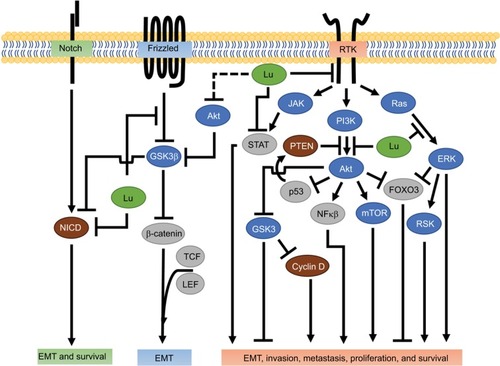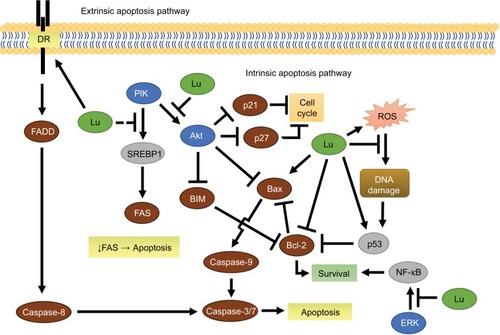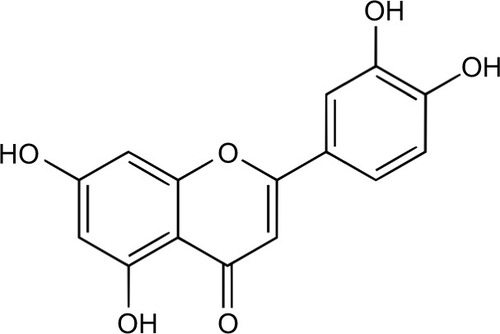Figures & data
Table 1 Effect of luteolin on breast cancer at a glance
Figure 2 Luteolin inhibition of receptor-mediated tumor progression.
Notes: Involvement of luteolin (green) in modifying processes necessary for metastasis. Notch activation results in removal of the intracellular domain of the membrane-bound Notch receptor, creating the NICD. NICD is blocked by luteolin through an undetermined mechanism. Wnt/β-catenin inhibits GSK3 activity upon activation. Luteolin blocks Wnt-induced phosphorylation of GSK3, and thus prevents GSK3 inhibition. Luteolin has been shown to inhibit RTK activities and their downstream effectors (see text for specific RTKs and associated effector responses). Possible outcomes for each receptor pathway are in the corresponding colored boxes. Intracellular proteins color-coded as protein kinases (blue), TCFs (gray), and other proteins (brown). Dashed line represents possible luteolin interaction.
Abbreviations: EMT, epithelial–mesenchymal transition; JAK, Janus kinase; Lu, luteolin; NICD, notch intracellular domain; RSK, ribosomal S6 kinase; RTK, receptor tyrosine kinase; TCF, transcription factor.
Abbreviations: EMT, epithelial–mesenchymal transition; JAK, Janus kinase; Lu, luteolin; NICD, notch intracellular domain; RSK, ribosomal S6 kinase; RTK, receptor tyrosine kinase; TCF, transcription factor.

Figure 3 Luteolin-mediated extrinsic and intrinsic apoptosis in breast cancer.
Notes: Illustration abridging the involvement of luteolin (green) in purposed apoptotic pathways. Luteolin sensitized the DR, activated caspase 8, and induced caspase 3-mediated apoptosis. Decreased FAS activity directly or indirectly by luteolin leads to apoptosis through an unknown mechanism. Inhibition of Akt or ERK leads to increased activity in the intrinsic apoptosis pathway. Circumstantially, luteolin acts as an antioxidant or drives ROS-mediated apoptosis. Intracellular proteins color-coded as protein kinases (blue), TCFs (gray), and other proteins (brown). Dashed line represents possible luteolin interaction.
Abbreviations: DR, death receptor; Lu, luteolin; ROS, reactive oxygen species; TCFs, transcription factors.
Abbreviations: DR, death receptor; Lu, luteolin; ROS, reactive oxygen species; TCFs, transcription factors.


